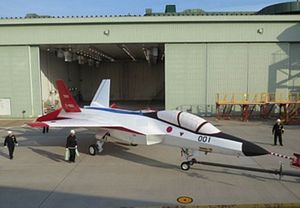Japan’s Ministry of Defense Technical Research and Development Institute (TRDI) announced that a prototype of Tokyo’s first indigenously-designed fifth-generation air superiority fighter, the Mitsubishi ATD-X Shinshin, will make its maiden flight in February 2016, according to Japanese media reports.
Prior to its first test-flight, the aircraft will undergo extensive taxiing and ground trials at the Mitsubishi Heavy Industries testing center located in Aichi Prefecture on Japan’s main island of Honshu. From there the fighter prototype is expected to fly to Gifu Air Field, an airbase of the Japan Air Self-Defense Force, situated in the neighboring prefecture of Gifu sometime in February.
The principal objective of the ATD-X Shinshin program is to develop a research prototype aircraft — an“advanced technology demonstration unit” — to test the capacity of Japan’s defense industry to develop, among other things, a powerful fighter engine and various other indigenous stealth fighter aircraft technologies.
The program is meant to eventually produce Japan’s first indigenously-designed fifth-generation air superiority fighter, designated F-3, with serial production slated to begin in 2027, although various delays in the development of the ATD-X Shinshin prototype – scheduled to be fully developed by 2018– make a later date more likely.
The reason behind the development of the F-3 is the refusal of the United States to sell to Japan the Lockheed-Martin F-22 Raptor stealth air superiority fighter in the 2000s. According to some media reports, Lockheed-Martin is playing an undetermined role in the development of the ATD-X prototype.
Among other things, the aircraft will feature 3D thrust vectoring capability. According to a The Diplomat contributor, other design characteristics include:
If completed, the F-3 is supposed to incorporate some cutting-edge technology. The aircraft will be fitted with an active electronically scanned array (AESA) radar. The radar will have capabilities for electronic countermeasures, communications functions, and possibly even microwave weapon functions. The Shinshin is planned to have a flight-by-optics flight control system. Data is transmitted by optical fibers rather than wires. In this way data is transmitted faster and is immune to electromagnetic disturbance. Furthermore, the new Japanese aircraft will have a so-called self repairing flight control capability. It will allow the aircraft to detect failures or damage in its flight control surfaces.
So far, one full-scale ATD-X prototype has been constructed. Back in 2011, Japan decided to procure 42 F-35 Lightning II Joint Strike Fighters, the first of which are scheduled to arrive at the end of 2016. The F-35 Joint Strike Fighter procurement is an interim solution until Tokyo can field its own indigenous fifth generation fighter.
































